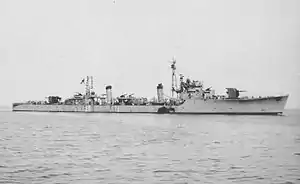 Sister ship Momi, 4 September 1944 | |
| History | |
|---|---|
| Name | Ume |
| Namesake | Japanese apricot |
| Builder | Fujinagata Shipyards, Osaka |
| Laid down | 25 January 1944 |
| Launched | 25 April 1944 |
| Completed | 28 June 1944 |
| Fate | Sunk by aircraft, 31 January 1945 |
| General characteristics (as built) | |
| Class and type | Matsu-class escort destroyer |
| Displacement | 1,282 t (1,262 long tons) (standard) |
| Length | 100 m (328 ft 1 in) (o/a) |
| Beam | 9.35 m (30 ft 8 in) |
| Draft | 3.3 m (10 ft 10 in) |
| Installed power |
|
| Propulsion | 2 shafts, 2 × geared steam turbines |
| Speed | 27.8 knots (51.5 km/h; 32.0 mph) |
| Range | 4,680 nmi (8,670 km; 5,390 mi) at 16 knots (30 km/h; 18 mph) |
| Complement | 210 |
| Sensors and processing systems | |
| Armament |
|
Ume (梅, "Japanese apricot") was one of 18 Matsu-class escort destroyers built for the Imperial Japanese Navy near the end of World War II. She was completed on June 28, 1944, and would be sunk near the Philippines by US bombers.
Career
Ume was completed on June 28, 1944, and was assigned to the 11th Destroyer Squadron for training, on July 15 she was assigned to the 43rd Destroyer Division as the flagship with Captain Sugama Ryokichi. On August 20 the 43rd Destroyer Division would be reassigned to the 31 Escort Squadron.[1]
On October 25, 1944, Ume and her sister ships Momi and Momo escorted light carrier Ryūhō and escort carrier Kaiyō, they left Sasebo and when to Keelung in Taiwan to transport aviation material. They would return to Kure on November 2.[2]
On November 8 Ume departed Kure with the battleship Ise for Manila. As they would near the Philippines they received reports of an air raid on Manila and diverted to the Spratly Islands and would arrive there on the 14th. She would then join the escort for Admiral Kurita's fleet after their battle off Samar and would then break off at Mako.[3]
On December 5, 1944, Ume would lead TA No.8, a resupply mission for Japanese troops currently defending against the American Invasion of the Philippines. They would be landing supplies and the 68th Brigade in Ormoc, they were carried by the transports Akagisan Maru, Hakuba Maru, Shisei Maru, Nichiyo Maru, and the fast transport T.11 with the escort consisting of Ume, Momo, Sugi, and Subchasers No. 18 and 38. On December 7 they were attacked by the US 5th Airforce causing damage to all ships. The Transports were ordered to be beached north of Ormoc since the US had begun an invasion a few miles south of there, the soldiers aboard the transports would land but nearly all of the other material would be lost. The escorts were then ordered to head north to avoid more air attacks. Ume would go to Hong Kong for repairs due to the damage she received during the attacks.[4]
Ume would lead an evacuation run for air crew stationed in Aparri. She left on January 30, 1945, from Takao with Shiokaze and one her sister ships Kaede. The next day January 31st twelve B-52s of the 822nd Squadron attacked the ships sinking Ume as well as damaging Kaede and Minekaze.[5] 77 were killed and 36 were wounded, the survivors would be picked up on Shiokaze. Due to the air attacks the evacuation run was aborted.[3]
References
- ↑ The Japanese Monographs, Prepared by the Military History Section of the Headquarters, Army Forces East, Distributed by the Office of the Chief of Military History, Department of the Army, No. 116, p.36-37
- ↑ Tully, Anthony. "IJN Ryuho: Tabular Record of Movement". www.combinedfleet.com. Archived from the original on 2023-11-03. Retrieved 2023-11-03.
- 1 2 Nevitt, Allyn. "IJN Ume: Tabular Record of Movement". www.combinedfleet.com. Archived from the original on 2023-11-03. Retrieved 2023-11-03.
- ↑ Nevitt, Allyn. "The TA Operations to Leyte, Part III". www.combinedfleet.com. Archived from the original on 2023-11-03. Retrieved 2023-11-03.
- ↑ Futrell, Frank (1983). "Luzon". In Craven, Wesley & Cate, James (eds.). The Pacific: Matterhorn to Nagasaki: June 1944 to August 1945 (PDF). The Army Air Forces in World War II. Washington, D.C.: Office of Air Force History. OCLC 314452548. Retrieved 3 November 2023.
Bibliography
- Jentschura, Hansgeorg; Jung, Dieter & Mickel, Peter (1977). Warships of the Imperial Japanese Navy, 1869–1945. Annapolis, Maryland: United States Naval Institute. ISBN 0-87021-893-X.
- Nevitt, Allyn D. (1998). "IJN Ume: Tabular Record of Movement". www.combinedfleet.com. Retrieved 21 September 2020.
- Rohwer, Jürgen (2005). Chronology of the War at Sea 1939–1945: The Naval History of World War Two (Third Revised ed.). Annapolis, Maryland: Naval Institute Press. ISBN 1-59114-119-2.
- Stille, Mark (2013). Imperial Japanese Navy Destroyers 1919–45 (2): Asahio to Tachibana Classes. Botley, UK: Osprey Publishing. ISBN 978-1-84908-987-6.
- Sturton, Ian (1980). "Japan". In Chesneau, Roger (ed.). Conway's All the World's Fighting Ships 1922–1946. Greenwich, UK: Conway Maritime Press. ISBN 0-85177-146-7.
- Whitley, M. J. (1988). Destroyers of World War Two: An International Encyclopedia. Annapolis, Maryland: Naval Institute Press. ISBN 0-87021-326-1.